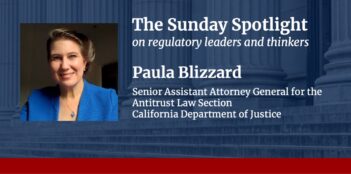
European countries have taken varied approaches to curtailing use of too-thin models—will the U.S. take action, too?
Kate Moss has appeared on 34 covers of British Vogue and was recently recognized by the British Fashion Awards for her status as a style icon for young women. But at the peak of her fame, Britain’s wealthiest model registered a body mass index (BMI) of just 15, making her “severely thin” according to World Health Organization standards.
Moss’s low BMI is hardly the exception to the fashion industry rule: the average runway model is twenty percent underweight. Although she once declared that “nothing tastes as good as skinny feels,” the risks associated such low BMIs and associated eating disorders include heart failure, memory loss, and osteoporosis.
European regulators have stepped up to combat the fashion industry’s practice of using underweight models, citing not only the health risks faced by models themselves, but also the message sent to young girls who idolize and emulate them. Different counties have employed vastly different regulatory approaches, ranging from France’s weight minimums to the United Kingdom’s requirement that fashion ads employ “a sense of responsibility to consumers.”
The United States has yet to regulate model weight.
But the weight-related deaths of several prominent models in recent years have prompted calls around the world for model-weight regulation. Research indicates that the fashion industry negatively influences children: seventy percent of girls ages 10 to 18 report that they define “perfect body image” based on what they see in magazines. Furthermore, a study from the British Medical Association confirmed “a link between the ‘abnormally thin’ models found in fashion magazines” and increased rates of anorexia nervosa and bulimia nervosa in the general population. More people die from anorexia and bulimia than from any other mental health problem.
But fashion industry leaders argue that thinness does not necessarily indicate the presence of an eating disorder. “It’s very serious to conflate anorexia with the thinness of models,” says Isabelle Saint-Félix, secretary general of Synam, which represents around 40 modeling agencies in France. “It ignores the fact that anorexia is a psychogenic illness.”
France has taken what is arguably the strictest approach to regulating model weight. In April of this year, it followed the lead of countries like Israel and Spain by passing a law that requires models to present their employers with a doctor’s note vouching that they have a BMI of at least 18. Agencies that violate the law can face up to $82,000 in fines, with individual agents facing punishments of up to six months in jail.
Critics of the French law assert that BMI is an imprecise benchmark, as healthy BMIs vary by geographic ancestry. But proponents say that the law is nonetheless necessary, because it will spark real change throughout the fashion industry, given that Paris makes up its epicenter.
By contrast, the United Kingdom’s Advertising Standards Authority regulates the weight of fashion models through consumer complaints. For example, a single complaint recently led the Authority to mandate that Gucci refrain from running an ad that featured a “thin and gaunt model.” The Agency found that the ad violated its requirement that marketing communications “be prepared with a sense of responsibility to consumers and society.”
Denmark has taken yet another approach. The Danish Fashion Ethical charter, signed by over 300 businesses, requires that models receive an annual health check in order to participate in Copenhagen Fashion Week.
The United States has yet to regulate the weight of fashion models, but change might be on the horizon. Earlier this year, California legislator Marc Levine introduced a bill in the state assembly that would require the modeling industry to adopt health standards, including periodic health check-ups. Industry leaders have opposed the bill, calling it unworkable.
Some experts have called for federal regulation. Massachusetts Health Policy Commission deputy director Katherine Record and Harvard Professor S. Bryn Austin argue that the Occupational Health and Safety Administration (OSHA), which regulates workplace hazards that “create a risk of material health impairment,” has the authority to regulate model weight given the health risks associated with low BMIs. Although OSHA is better known for regulating health risks like black lung among coal miners, attorney Cassandra Soltis has asserted that it may delve into areas not typically thought of as occupational health or safety hazards.
Some public health experts argue that such protections would make a big difference. Just as a fashion designer cannot “survive” without attending Paris Fashion Week, a designer probably cannot survive without attending New York Fashion Week.
But the fashion industry would almost certainly seek to block U.S. federal regulation, say some experts. In addition to arguing that BMI is an arbitrary metric, industry groups are likely to argue that OSHA lacks regulatory authority due to models’ status as independent contractors. In addition, the Americans With Disabilities Act currently prohibits employers from discriminating against qualified employees who have a disability, defined as an impairment that “substantially limits” a major life activity—a category which includes anorexia nervosa.
Attorney Katherine Record, however, asserts that courts would reject these arguments some fashion firms might advance. On the independent contractor claim, courts defer to contractual designations, instead evaluating the level of control exerted by the employer, which Record believes to be high. She also argues that a minimum BMI requirement would not violate the ADA, so long as it is implemented to protect employee health and is low enough so as not to exclude healthy models with naturally low BMIs.
University of Wisconsin Professor Donald Downs has advanced another possible legal obstacle to U.S. regulation of models’ weight: the First Amendment. America’s “cultural support for free speech in cases in which the harm is not direct or clear” would further hamper regulatory efforts, he says. These kinds of First Amendment objections might be raised most effectively to regulatory efforts, such as Federal Trade Commission deceptive advertising action, that would affect product advertisements containing images of fashion models.



